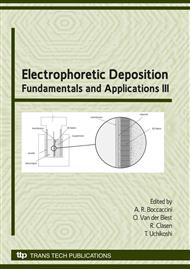p.9
p.15
p.21
p.27
p.33
p.39
p.45
p.51
p.59
Aqueous Electrophoretic Deposition at High Electric Fields
Abstract:
From an environmental, safety and economic perspective water should be the solvent of choice for electrophoretic deposition under industrial circumstances. However, because of the electrolytic decomposition of water under the influence of direct current, the majority of EPD is carried out in non-aqueous solvents. In this work, experiments prove that deposits can be obtained from aqueous alumina suspensions while avoiding electrolysis of the medium by using unbalanced alternating current fields [1]. In addition it is shown that the formed deposits have a green density which is intrinsically higher than those formed by traditional DC EPD from ethanol based suspensions. A theoretical basis for both electrophoretic deposition by means of unbalanced alternating fields and the higher density of deposits formed by application of such fields is provided.
Info:
Periodical:
Pages:
33-38
Citation:
Online since:
June 2009
Authors:
Price:
Сopyright:
© 2009 Trans Tech Publications Ltd. All Rights Reserved
Share:
Citation:


